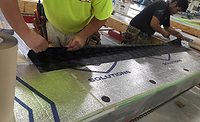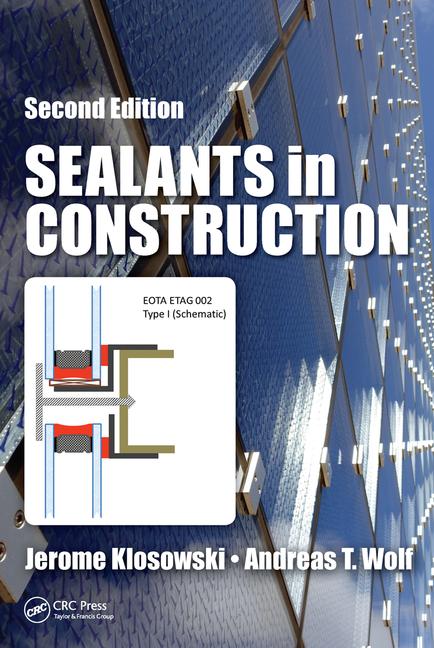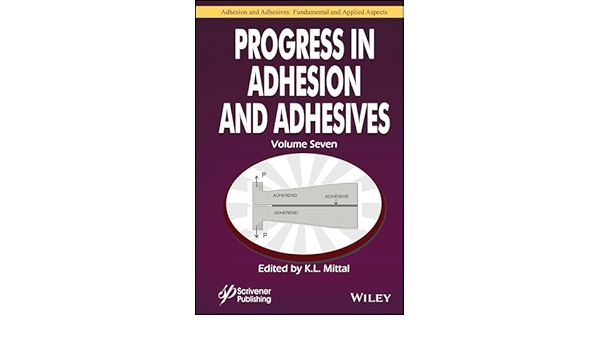Pre-Cured Construction


The basic steps involved in installing pre-cured sealant include the application of the adhesive (a, here), pressing the pre-cured sealant into place (b) and the completed installation (c).
Pre-cured sealants are most commonly produced as flat extrusions with a thickness of approximately 2 mm and sizes (widths) that vary from 0.5 in. to 14 in. wide. Pre-cured sealants are readily available in many standard sizes and colors. Manufacturers also offer custom color and custom design pre-cured sealants to fit different application requirements. Custom pre-cured sealants are available with a variety of surface textures designed to match the appearance of exterior insulation and finish systems (EIFS), stucco, and other surfaces. Pre-cured sealants can also be produced with one or more notches in the extrusion. These notches allow the pre-cured sealant to bend uniformly in specific locations and seal complex configurations in applications such as inside and outside corners, parapet caps, window mullions, and others.
Because of its excellent aging characteristics, resistance to ultraviolet light and weathering, and long effective lifespan, silicone is almost always chosen for pre-cured sealants in construction-related applications. In addition, the movement capability for silicone pre-cured sealants is commonly +200%, significantly higher than other types of sealing products. The combination of high movement capability and thin material allows silicone pre-cured sealants to easily handle multi-directional movement. Additional advantages of silicone over other materials include a wide operational temperature range and better resistance to color fading.

The basic steps involved in installing pre-cured sealant include the application of the adhesive (a), pressing the pre-cured sealant into place (b, here) and the completed installation (c).
Commercial Building Envelope Repair
Pre-cured silicone sealants have been used in North America over the past two decades in the construction industry, mainly for commercial building envelope repair applications, such as the repair of failed building (standard) sealant joints. The opening photo of this article shows a 3-in.-wide sandstone colored pre-cured sealant being installed over an existing failed traditional sealant joint. Notice the adhesive near the outside edge of the material. When pre-cured sealants are used to repair a failed traditional sealant joint, it is not necessary to remove the old sealant; the pre-cured sealant is simply applied over the old joint using a thin layer of adhesive on each side of the pre-cured sealant extrusion.One of the biggest advantages of using pre-cured sealants in these applications is that, because they can be installed directly over the existing failed sealant and the old sealant does not need to be removed, labor cost savings can be significant. Several of the most common building envelope repair applications include:
- Failed joint repair
- EIFS joint repair
- Undersized expansion joints
- Roofing and parapet seals
- Flashing
- Splice joints
- Skylights
- Curtainwall seals
- Window perimeter seals
- Window glazing
Additional applications that are ideal for pre-cured sealants include repair of joints in EIFS or other soft substrates that could be significantly damaged by removing the existing sealant. Because the existing sealant material is not disturbed during installation, applications where the substrates or existing sealants contain hazardous materials such as asbestos or PCBs can also be properly addressed with pre-cured sealants.

The basic steps involved in installing pre-cured sealant include the application of the adhesive (a), pressing the pre-cured sealant into place (b) and the completed installation (c, here).
Metal Buildings
While pre-cured silicone sealants have been used for many years in building envelope restoration applications, it is only within the past five years that some forward-thinking manufacturers and erectors in the metal building industry have begun to use them. Several key features of pre-cured sealants make them ideal for metal building-related applications. Pre-cured sealants’ flexibility and high movement capability make them perfect for sealing areas that experience a significant amount of thermal expansion and contraction, a situation commonly found in metal building and roofing applications. In addition, UV stability keeps pre-cured silicone sealants from degrading under the intense, long-term exposure to weather and the elements routinely found in these applications.One of the most important features of pre-cured sealants for metal building applications is that they require no mechanical fasteners for installation. The green strength of the adhesive allows pre-cured sealants to be installed with no other means of attaching the material to the substrate, even when installed on a vertical surface. This enables the quick and efficient installation of pre-cured sealants, particularly when compared to other systems commonly used in these and similar applications.
Other all-metal systems or “membrane” systems generally require many mechanical fasteners (as many as 1,500 fasteners per 100 linear ft of material), in addition to sealants and/or mastics. The large amount of fasteners dramatically increases the time and labor cost required for the installation of these systems. Since each and every fastener creates another hole in the roof, the potential for leaks is also increased.
Pre-cured sealant systems are currently being installed successfully in many different applications within the metal buildings industry, including:
- Expansion joints
- Roof-to-wall transitions
- Roof height change details
- Joints between new and existing buildings
- Roof gutter seams
- Ridge applications
- Roof penetrations
- Roof curb seals
Pre-cured sealants are also commonly used in various metal building repair applications related to metal roofing. Some of these applications include the repair of holes in roof decking and the repair of failed standing seams, as well as other roofing repairs.

One of the most important features of pre-cured sealants for metal building applications is the fact that no mechanical fasteners are required for installation.
Storage Bins
Another construction-related area of application for pre-cured sealants is large storage containers, such as grain storage bins. These storage bins require a watertight design to keep the contents dry and isolated from insects and other animals. Pre-cured sealants’ flexibility, weather resistance, and ability to adhere to a variety of substrates make them ideal for sealing storage bins. Pre-cured sealants can be used in the following applications:- Sealing between the storage bin and the concrete support slab
- Wall-to-roof joints
- Sealing around openings and penetrations
- Gaskets for openings and bin access points

Pre-cured sealants can be easily cut to seal straight or rounded penetrations, including vents, windows and doors.
RV/Cargo Trailers
Pre-cured sealants are effective in a variety of waterproofing applications in RV and cargo trailer manufacturing and repair. Their flexibility and uniform size allow pre-cured sealants to be used more effectively for these applications than typical caulk, while also maintaining an aesthetically pleasing appearance. Pre-cured sealants can be easily cut to seal straight or rounded penetrations, including vents, windows and doors. Pre-cured sealants also provide a long-lasting seal that won’t crack, dry out or leak like other types of sealants and caulk commonly used in these applications.Their unique properties allow pre-cured sealants to be used for a variety of RV- and cargo trailer-related applications, including:
- Vent, ladder and antenna penetrations
- Roof-to-wall transitions
- Sealing roof and wall seams
- Repairing failed caulk
- Holes, tears and other repair applications
- RV windows and doors
- Interior applications, such as shower enclosures

Pre-cured sealants installed in a residential window application.
Residential Applications
Many of the same attributes that make pre-cured sealants an excellent choice for various commercial and industrial applications also allow them to perform effectively in residential applications. Pre-cured sealants can be used in sealing areas such as windows, skylights, roofing, HVAC and many other household applications. The simple, easy-to-follow installation procedure for pre-cured sealants makes them ideal for the homeowner and handyman, as well as professional contractors.The photo above shows pre-cured sealants installed in a residential window application. In this particular application, the pre-cured sealant is installed in two different areas of the window system where the existing sealant and gasket material have failed and caused water leaks. Both of these installation areas are corners, which demonstrate the flexibility of pre-cured sealants as well as their ability to be installed in various configurations. This application is an example of where notched pre-cured sealants can be bent into different shapes and installed in areas such as corners and window mullions.
In addition to the capability of pre-cured sealants to seal leaks and keep homes watertight, they can also benefit the homeowner because of their capacity to stop air leaks. Sealing air leaks is a critical part of reducing heating and cooling losses and thus reducing the overall energy usage and costs.

A pre-cured sealant pad being used for tooling of a hot-melt butyl IG sealant.
Non-Standard Forms
In addition to the previously discussed standard (flat) and notched materials, pre-cured sealants can also be extruded in various shapes to perform explicit functions. One example of a non-standard pre-cured sealant is a thicker, ribbed material that is cut into pieces (often called pads) and used as an accessory during the production of insulating glass (IG) units used in windows and doors. Hot-melt butyl sealant is commonly incorporated into IG units. Certain silicone pre-cured sealant formulations will keep the hot-melt sealant from sticking to it, allowing the pre-cured sealant pad to be used as a tooling device. In addition, the thicker material helps insulate the user from the heat of the hot IG sealant, making it safer to use than other materials for this application.Additional examples of non-standard pre-cured sealants include:
- Rectangular gaskets used for various applications, including sealing doors and other openings
- Triangular or trapezoidal shapes for repairing failed glazing gaskets on windows
- Thicker (up to 6 mm) material used for applications where more abrasion resistance is required
The Green Factor
Pre-cured sealants can help address an issue that is critical for construction today: a greener building. Many buildings, both new and existing, have numerous leaks in the building envelope (often in the joint areas). Virtually any area in a building that is susceptible to leaks can be sealed using pre-cured sealants. The building is more energy efficient once these leaks are sealed, and a significant reduction of heating and cooling costs can be realized.In fact, improved energy efficiency and other factors allow pre-cured sealants to be an integral part of obtaining LEED certification for either new construction or existing buildings, particularly in the areas of Minimum Energy Performance (Prereq 2), Optimize Energy Performance (Credit 1), Low-Emitting Materials: Adhesives & Sealants (Credit 4.1), and Thermal Comfort: Design (Credit 7.1). In addition, the manufacturing efficiency and ability for production waste material to be recycled make pre-cured sealants a truly green product.
Continued Growth
In addition to all the applications discussed here, pre-cured sealants are also used in other areas such as marine, transportation and industrial-related applications. Pre-cured sealants can be used effectively in any application where flexibility, movement capability, ease of installation and/or a watertight or airtight seal are needed. As leaders in the construction industry continue to realize the impact that cost savings, product performance and efficiency can make in a variety of applications, it is expected that the market for pre-cured sealants will continue to grow.For additional information, contact the author at (231) 348-5020 or jbakus@sealexinc.com, or visit www.sealexinc.com.
Links
Looking for a reprint of this article?
From high-res PDFs to custom plaques, order your copy today!








